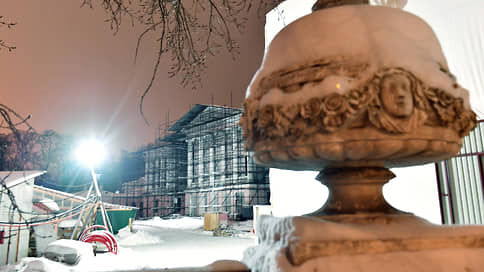Moscow authorities have announced a tender for the restoration of the Ostankino museum-estate
[ad_1]

The capital’s authorities have announced a tender for the restoration of the facades and pavilions of the Ostankino estate, an architectural monument of the 18th century. The former estate of the Sheremetev counts is noteworthy as the only surviving wooden palace-theater of its kind. Over the past hundred years it has been restored four times, but since 2013 it has been closed to the public. The current renovation will take two years and will include the Italian pavilion-theater in one of the two wings of the estate.
The tender for restoration work in the Ostankino estate – “with adaptations for modern use” – was posted by the capital’s state government institution “Mosrestavratsiya” on the website zakupki.gov.ru. We are talking about a cultural heritage site of federal significance in Ostankino Park in the north of Moscow. The estate in the former estate of the Sheremetev counts was built mainly from pine. The contractor is expected to involve both architects and restoration artists specializing in “easel oil painting”, and restorers of monuments of wooden and stone architecture, as well as “decorative plasters and stucco products”. Judging by the documentation, the task is to put in order the facades of the palace, the rotunda on its territory, fences, lanterns, the western wing and the theater – the Italian pavilion in the mansion (located in one of its two wings). The work must be completed within two years, the contract amount is 3.29 billion rubles; Applications are accepted until February 9.
Two-story U-shaped estate with an area of 4.1 thousand square meters. m was built according to the design of architects Francesco Camporesi, Ivan Starov and Vincenzo Brenna in the classicist style in 1792–1798. Count Nikolai Sheremetev planned to combine a gallery, library and theater in it (the latter has, for example, wooden machines for creating sound effects of thunder, rain and wind). In 1917, the Ostankino estate was issued a safe conduct letter from the Moscow Council of Workers’ and Soldiers’ Deputies. In 1918, it became part of the museum system of the People’s Commissariat for Education and a year later was open to the public. The complex also includes the Church of the Life-Giving Trinity, a front yard and a park. The Ostankino Palace is characterized as the only wooden theater of the 18th century (with a stage, auditorium, dressing rooms and part of the engine room), which reached its contemporaries almost unchanged.
Since 2013, the Ostankino estate has been closed to visitors for restoration. In 2015, Alexander Kibovsky, who held the post of head of the Moscow City Heritage Service, estimated that this process would take from three to seven years. By that time, 2.5 billion rubles had been allocated for restoration needs. from the capital’s budget, and it was planned to allocate 9.6 billion rubles in total, the city mayor’s office said. Earlier, Mr. Kibovsky spoke about the capital’s desire to involve specialists from the palace complexes of Versailles and Sans Souci in the restoration. The Moscow City Heritage Agency reported that only “authentic materials” – brick, wood and plaster – will be used during the restoration.
In 2016, the reconstruction project for the Ostankino estate was approved by Glavgosexpertiza. There it was called the world’s largest restoration project after the reconstruction of Tsarskoe Selo, Pavlovsk and Peterhof. The project involved restoring the 18th-century linden alley; a rampart and a ditch enclosing the park; a sculptural complex with a statue of Apollo in the center of the front courtyard, 14 busts and lost flowerpots. It was also supposed to recreate “according to historical drawings” the horse yard, storeroom, garden outbuilding and greenhouses. In 2020, restorers reported on the restoration of the historical parquet in the estate.
Over the past hundred years, the Ostankino estate has undergone four restorations, according to its website. Thus, in the 1930–1950s, “late deposits were cleared,” and in the 1960–1980s, the Egyptian pavilion and the actresses’ make-up room were repaired. The last work in the estate took place in 2004–2008: the cornice of the auditorium and the mezzanine floors were repaired. All this work “was of a local nature,” explains the Ostankino estate.
During the current restoration, judging by the documentation, it is planned to construct a temporary roof, fire and security alarms, as well as a rodent control system. In October 2023, the capital authorities approved a targeted investment program for 2024–2026 (with a total estimate of over 2.73 trillion rubles), mentioning the restoration of the Ostankino estate as one of the important objects.
“It is extremely important that the restoration finally approaches completion and the monument lives a full life. Otherwise, Muscovites have begun to forget that the estate has always been a museum,” says Konstantin Mikhailov, coordinator of the public movement “Arkhnadzor” (which advocates the preservation of historical monuments). The expert also sees advantages in lengthy restoration: “Wooden estates are still found in Moscow, but a wooden estate palace of such a high level is unique. In recent years, controversial ideas have been proposed – from the arrangement of a vast underground space under the complex to the construction of auxiliary buildings on its territory, but they have not been implemented. I hope the current project will be as gentle as possible.”
[ad_2]
Source link








